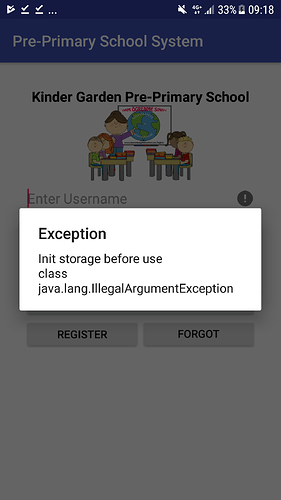Hi there,
I am getting an illegal argument exception if I use the following code. (See attachment)
I already gave my app permission to go on the internet in the manifest file. I also created a DefaultCallback and InitializeBackendless class. Within the InitializeBackendless class I have entered the App ID and the API key it still gave me an error. (See attachment for output). I have commented out the code I attached and I do not get an exception. That is how I know the exception was given from that code. Do you have any ideas what I can do to fix it?
Here is a background of what happened:
Due to permission problems on my pc I had to recreate the application and I also deleted the project from backendless to recreate it. I changed the App ID and API Key in my project from the old key. The ID and the Key is new. I know the problem is not there.
Hi Rhinwen,
Is it a Java or Android app? Where do you have Backendless.initApp call?
The application is an android app. And I am calling the Backendless.initApp within my InitializeBackendless.java class. And I have add backendless in my gradle (Module: app)
Try calling UserIdStorageFactory.instance().init( Context ) before your .loggedInUser() call.
Hi it still gives me the same error. By the way where can I read up on the code you gave me? I want to know what it does. I tried here but do not understand the way they present it.
Please prepare a minimal verifiable sample so that we could reproduce the problem.
Hi I solved the Issue. Thank you for the help.
What was the problem?
I initialized Backendless in another class using the onCreate method. That worked in the past tho. I just initialized it before the code in the same class instead.
Before:
Backendless.UserService.isValidLogin( new DefaultCallback<Boolean>( LoginScreen.this )
{
@Override
public void handleResponse( Boolean isValidLogin )
{
if( isValidLogin && Backendless.UserService.CurrentUser() == null )
{
// UserIdStorageFactory.instance().init( LoginScreen.this );
String currentUserId = Backendless.UserService.loggedInUser();
if( !currentUserId.equals( "" ) )
{
Backendless.UserService.findById( currentUserId, new DefaultCallback<BackendlessUser>( LoginScreen.this, "Logging in..." )
{
@Override
public void handleResponse( BackendlessUser currentUser )
{
super.handleResponse( currentUser );
Backendless.UserService.setCurrentUser( currentUser );
startActivity( new Intent( getBaseContext(), Welcome_Screen.class ) );
finish();
}
} );
}
}
super.handleResponse( isValidLogin );
}
});
//AFTER:
Backendless.setUrl(InitializeBackendLess.Server_URL);
Backendless.initApp(LoginScreen.this,InitializeBackendLess.App_ID,InitializeBackendLess.API_Key);
Backendless.UserService.isValidLogin( new DefaultCallback<Boolean>( LoginScreen.this )
{
@Override
public void handleResponse( Boolean isValidLogin )
{
if( isValidLogin && Backendless.UserService.CurrentUser() == null )
{
// UserIdStorageFactory.instance().init( LoginScreen.this );
String currentUserId = Backendless.UserService.loggedInUser();
if( !currentUserId.equals( "" ) )
{
Backendless.UserService.findById( currentUserId, new DefaultCallback<BackendlessUser>( LoginScreen.this, "Logging in..." )
{
@Override
public void handleResponse( BackendlessUser currentUser )
{
super.handleResponse( currentUser );
Backendless.UserService.setCurrentUser( currentUser );
startActivity( new Intent( getBaseContext(), Welcome_Screen.class ) );
finish();
}
} );
}
}
super.handleResponse( isValidLogin );
}
});
